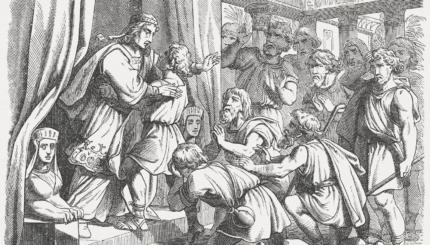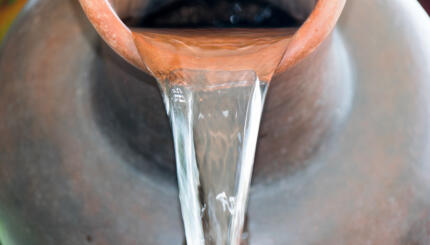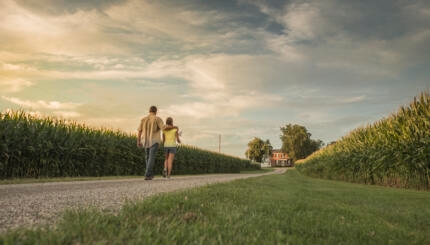This commentary is provided by special arrangement with Canfei Nesharim. To learn more, visit www.canfeinesharim.org.
 God, the creator of all substances in nature, has put before us elements that can heal us in small concentrations and affect us detrimentally in large ones. In this week’s Torah portion, we are reminded of one such element, sulfur, and can learn from it an important ecological and religious message.
God, the creator of all substances in nature, has put before us elements that can heal us in small concentrations and affect us detrimentally in large ones. In this week’s Torah portion, we are reminded of one such element, sulfur, and can learn from it an important ecological and religious message.
Sulfur is one of a vast array of simple and complicated chemicals in nature. In small quantities and in low concentrations, sulfur is used in homeopathic healing. It heals diseases and agitations related to burning, such as with skin, heart, and joints, and can be used to treat individuals that suffer from an inability to connect with their surroundings, show forgetfulness, and other similar characteristics.
However, in vast quantities and high concentrations, sulfur is very destructive. It has the ability to acidify arable land, making it unfit for growing crops. When it is found in rainwater, it changes the pH level and therefore detrimentally affects plant growth.
With your help, My Jewish Learning can provide endless opportunities for learning, connection and discovery.
Sodom & Gemorrah
One of the most famous biblical passages regarding sulfur is the story of Sodom and Gemorrah found in the Book of Genesis and referenced in this week’s Torah portion, Nitzavim: “Sulfur and salt, a conflagration of its entire land, it cannot be sown and it cannot sprout and no grass shall rise up on it; like the upheaval of Sodom and Gemorrah, Admah and Zeboim which God overturned in his anger and his wrath (Deut. 29:22).”
What happened at the destruction of Sodom and Gemorrah? We know that the area began as a most fertile region (Genesis 13:10), and then became desolate and infertile, but how did that change come about?
The Torah indeed describes the process of Sodom’s upheaval: “And God had rained upon Sodom and upon Gemorrah sulfur and fire, from God, out of heaven. He overturned these cities and the entire plain, and all the inhabitants of the cities and the vegetation of the soil (Genesis 19:24).” The Torah tells us that the sulfur and fire came down at the same time; we know from the scientific properties of sulfur that it in fact burns due to its acidity.
Acid Rain
Rashi (on Genesis 19:24) teaches that what came down on Sodom and Gemorrah was at first rain, and only then sulfur and fire. In modern times the combination of these elements is reminiscent of acid rain. As water evaporates, it combines with acidic additives from car exhaust, factory smokestacks, and coal generating plants during raindrop formation to make acid rain.
So just as Sodom and Gemorrah were hit with rain and then sulfur, we experience, to a lesser degree, acid rain caused by pollution. In Scandinavia, for example, acid rain has caused some lakes to lose all their fish populations. While the repairing of this effect does take place naturally over great expanses of time, it affects the food and livelihood of entire regions, and can even compromise human health and safety.
The issue of acid rain has, for the most part, decreased in the northeastern seaboard of the United States and Canada. However, it remains an issue in developing parts of the world as these economies attempt to imitate a Western standard of living, following the same environmentally irresponsible industrial patterns seen in the West. One direct action we can take to stop this from occurring is to invest in clean technologies in order to encourage their use in developing parts of the world.
It seems clear that the more we look towards and use alternative fuels and renewable sources of energy, the less acid rain we will experience in the future. Perhaps this is because we will be showing sensitivity for our fellow human beings that did not exist in Sodom and Gemorrah.
Social Consciousness & Responsibility
The Torah Temimah (Rabbi Baruch HaLevi Epstein, 1860-1941), elucidating the characteristics of those living in Sodom versus those living in Jerusalem, teaches us in the name of Raba and Rabbi Yochanan, that the women of Jerusalem had one trait that the women of Sodom did not have.
The women of Sodom (a wealthy city) refused to provide bread (the mainstay of a meal) to the poor, whereas we learn about the Jewish women in the first chapter of the Book of Lamentations that “the hands of the women are merciful and provided to their children even though they did not have much (Sanhedrin 104b).”
This trait shows an ability to care about that which is beyond oneself. The problem of acid rain is a problem that stems from one not caring about what happens to the next person down the ecological line, whether on our home front or across the globe in less developed countries.
Normally, one’s punishment is proportional and related to their sin. This was the case in Sodom and Gemorrah. They did not care for outsiders, and therefore they were hit with a substance that was as harsh to them as they were to others. May we be blessed to care deeply about what comes out of our tailpipes and smokestacks, and through this holy concern merit to clear the skies and breathe the nourishing air God created.
Torah
Pronunced: TORE-uh, Origin: Hebrew, the Five Books of Moses.


